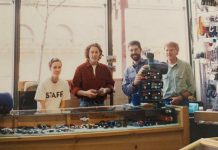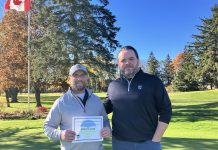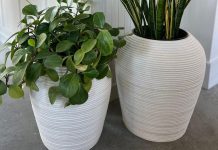
On Monday, November 6th, Peterborough GreenUP welcomed Caleb Musgrave from Canadian Bushcraft to the Peterborough Public Library to learn about medicinal plants.
Musgrave hosted a group of 54 people eager to listen and learn in a sharing circle. Musgrave brought forward knowledge from his extensive lived experience, both as an Anishinaabeg man and founder and owner of Canadian Bushcraft, an outdoor education school which operates out of Hiawatha First Nation.
During this event, Musgrave brought plants that he had found in his travel to the library. He painted a compelling picture of the past and present way that humans use plants as food — and as medicine — in the Peterborough and the Kawarthas area.
As a settler and staff member at GreenUP, I am excited to share three of my reflections from Musgrave’s workshop.
1. The Ojibwe language provides insight into the plants around us

In both Indigenous ways of knowing and in western scientific systems, naming conventions are one way that humans relate to plants.
In western ecology, we may use common names that depict dangers to our being, like “poison” ivy or “stinging” nettle. In English, it is also common to name plants after individuals, like the Joe-Pye weed. Interestingly, in historical accounts, I read that this plant in particular is likely to have been named after a medicine person from an unspecified First Nation.
I reflected on the comparison of these nuances to Anishinaabemowan (the Ojibwe language). The Ojibwe language is part of a knowledge system that provides much more insight into the plants and our relationship to them.
For example, mashkiigimin is the Ojibwe name for lowbush cranberry. “Mashkiig” can roughly translate to swamp, and tells us that the plant is found in wet ecosystems, with “min” meaning berry telling us the plant produces desirable fruit.
Anishinaabemowan uses names as descriptors and, with them, can tell a story about the life history of the plant and our relationship to them.
2. Urban forests can be food forests

During the workshop, Musgrave taught us that plants in Peterborough and the Kawarthas were intentionally planted and/or tended to by his Anishinaabeg ancestors as a method of terraforming.
This intentional cultivation of the landscape to provide ecosystem benefits and benefits to humans and non-humans alike is something that GreenUP and the Peterborough community orchard stewards are keen to learn about.
A group of volunteers, the Peterborough community orchard stewards care for 13 newly established urban food forests. These groves of fruit trees, berry bushes, and edible perennials were planted a couple of years ago to accompany the urban forest canopy.
An urban food forest here in Nogojiwanong-Peterborough could also be growing choke cherry trees, riverbank grape, and native currents, alongside larger plants like staghorn sumac and white oak — all of which have edible and medicinal properties.
The term ‘food forest’ became less prescriptive to me after hearing from Musgrave. We do not have to have an apple orchard in order to see that foods and medicinal plants are a vital part of our urban forests.
Cultivating native species is one way we can all continue to ensure that our communities benefit from thriving ecosystems.
3. Urban food forests require tending to, but they also require space to grow and establish

Urban food forests, like those planted by GreenUP, are different than mature forests. They require ongoing maintenance as they become established.
The understory, canopy, and sub-canopy all grow together in a unique balance between the plants. Plants with different roles may occupy the same space. For example, the edible wild strawberry may grow in the shade of the medicinal red-osier dogwood, which is also shaded by the useful black walnut.
Together these plants make up a type of food forest, but they become established as such over a long period of time.
Once plants like these are a part of the ecosystem of our parks, the food forest becomes home and habitat to support a diversity of human and non-human relations. It’s important to see and appreciate the way that plants relate to each other as they grow and become established.
Beyond my three reflections, it’s important to circle back to the conclusion that Musgrave offered in the workshop: that people approach plants with curiosity every day, at any age, as no one person can be an expert in all of what grows around us, but all of us can benefit from understanding our environment a little better.
I know that moving forward, with these reflections, I will remain curious about the foods and medicines around me.

GreenUP encourages readers to learn more about their local ecology by supporting Indigenous-led businesses, individuals, and non-profits who live in reciprocity with the land like Canadian Bushcraft, Creators Garden, Black Duck Wild Rice, and Alderville Mitigomin, to name a few.
The workshop with Caleb Musgrave was made possible by the Peterborough and District United Way as a part of the 2023 Community Orchard Stewards Program. Thank you to Orchard Stewards and the City of Peterborough and Nourish for their partnership in this program. Thanks as well to Starbucks for their support of this program.


























